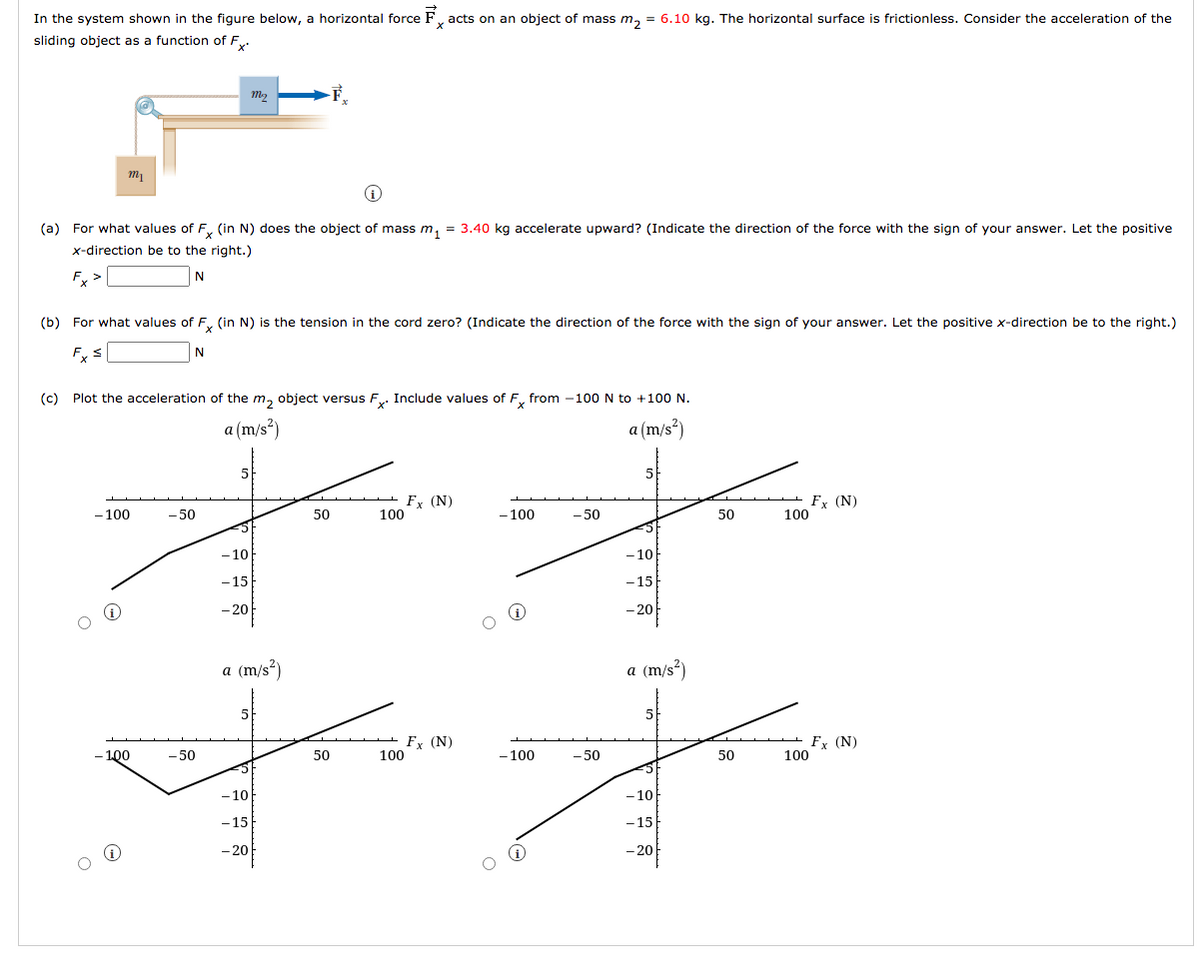In the system shown in the figure below, a horizontal force F, acts on an object of mass m, = 6.10 kg. The horizontal surface is frictionless. Consider the acceleration of the sliding object as a function of F. m2 (a) For what values of F, (in N) does the object of mass m, = 3.40 kg accelerate upward? (Indicate the direction of the force with the sign of your answer. Let the positive x-direction be to the right.) F,> (b) For what values of F, (in N) is the tension in the cord zero? (Indicate the direction of the force with the sign of your answer. Let the positive x-direction be to the right.) Fx s (c) Plot the acceleration of the m, object versus F. Include values of F, from -100 N to +100 N.
In the system shown in the figure below, a horizontal force F, acts on an object of mass m, = 6.10 kg. The horizontal surface is frictionless. Consider the acceleration of the sliding object as a function of F. m2 (a) For what values of F, (in N) does the object of mass m, = 3.40 kg accelerate upward? (Indicate the direction of the force with the sign of your answer. Let the positive x-direction be to the right.) F,> (b) For what values of F, (in N) is the tension in the cord zero? (Indicate the direction of the force with the sign of your answer. Let the positive x-direction be to the right.) Fx s (c) Plot the acceleration of the m, object versus F. Include values of F, from -100 N to +100 N.
Classical Dynamics of Particles and Systems
5th Edition
ISBN:9780534408961
Author:Stephen T. Thornton, Jerry B. Marion
Publisher:Stephen T. Thornton, Jerry B. Marion
Chapter2: Newtonian Mechanics-single Particle
Section: Chapter Questions
Problem 2.51P: Let us make the (unrealistic) assumption that a boat of mass m gliding with initial velocity v0 in...
Related questions
Question

Transcribed Image Text:In the system shown in the figure below, a horizontal force F.
acts on an object of mass m, = 6.10 kg. The horizontal surface is frictionless. Consider the acceleration of the
sliding object as a function of F.
(a) For what values of F, (in N) does the object of mass m, = 3.40 kg accelerate upward? (Indicate the direction of the force with the sign of your answer. Let the positive
x-direction be to the right.)
Fy>
(b) For what values of F,, (in N) is the tension in the cord zero? (Indicate the direction of the force with the sign of your answer. Let the positive x-direction be to the right.)
(c) Plot the acceleration of the m, object versus F. Include values of F, from -100 N to +100 N.
a (m/s?)
a (m/s*)
5
Fx (N)
100
Fx (N)
100
- 100
- 50
50
- 100
- 50
50
- 10
- 10
- 15
- 15
- 20
- 20
a (m/s²)
a (m/s²)
5
Fx (N)
100
Fx (N)
100
- 1,00
- 50
50
-100
- 50
50
- 10
-10
-15
- 15
- 20
- 20
Expert Solution
This question has been solved!
Explore an expertly crafted, step-by-step solution for a thorough understanding of key concepts.
This is a popular solution!
Trending now
This is a popular solution!
Step by step
Solved in 3 steps with 3 images

Knowledge Booster
Learn more about
Need a deep-dive on the concept behind this application? Look no further. Learn more about this topic, physics and related others by exploring similar questions and additional content below.Recommended textbooks for you

Classical Dynamics of Particles and Systems
Physics
ISBN:
9780534408961
Author:
Stephen T. Thornton, Jerry B. Marion
Publisher:
Cengage Learning

University Physics Volume 1
Physics
ISBN:
9781938168277
Author:
William Moebs, Samuel J. Ling, Jeff Sanny
Publisher:
OpenStax - Rice University

Principles of Physics: A Calculus-Based Text
Physics
ISBN:
9781133104261
Author:
Raymond A. Serway, John W. Jewett
Publisher:
Cengage Learning

Classical Dynamics of Particles and Systems
Physics
ISBN:
9780534408961
Author:
Stephen T. Thornton, Jerry B. Marion
Publisher:
Cengage Learning

University Physics Volume 1
Physics
ISBN:
9781938168277
Author:
William Moebs, Samuel J. Ling, Jeff Sanny
Publisher:
OpenStax - Rice University

Principles of Physics: A Calculus-Based Text
Physics
ISBN:
9781133104261
Author:
Raymond A. Serway, John W. Jewett
Publisher:
Cengage Learning